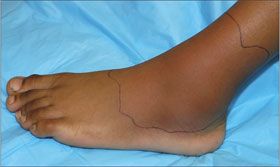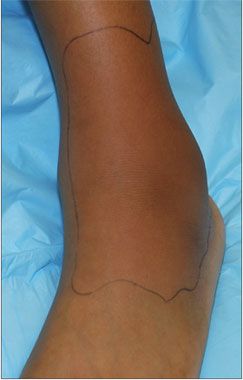Boy With Ankle Pain, Erythema, and Edema
THE CASE: A 7-year-old boy has had left ankle pain for 2 days. Neither he nor his mother can recall any recent trauma to the joint. He is usually very active, but he has been unable to bear weight on the left foot and has been resting in bed. His mother reports that he had some tactile fevers, which were transiently relieved with ibuprofen, and that he has been eating and drinking normally. Despite the application of ice and elevation, the ankle has become red and swollen.

Click to Enlarge
THE CASE: A 7-year-old boy has had left ankle pain for 2 days. Neither he nor his mother can recall any recent trauma to the joint. He is usually very active, but he has been unable to bear weight on the left foot and has been resting in bed. His mother reports that he had some tactile fevers, which were transiently relieved with ibuprofen, and that he has been eating and drinking normally. Despite the application of ice and elevation, the ankle has become red and swollen.
The child has had no previous hospitalizations or surgeries. Immunizations are up-to-date.
Temperature is 38.2°C (100.7°F); other vital signs are normal. Examination of the left lateral malleolus reveals a 12 x 10-cm area of erythema, warmth, and edema. There is no induration or fluctuance, pustules, vesicles, papules, or abrasions. Palpation reveals mild tenderness over the anterior aspect of the left foot and left ankle. Range of motion is minimally limited because of discomfort; pulses and sensation are intact.
What do you suspect?
•Septic arthritis
•Cellulitis
•Ankle sprain
•Osteomyelitis
(Answer and discussion on next page.)
Answer: Septic arthritis
DISCUSSION: The patient was transferred to the local emergency department (ED) for further evaluation and management. A radiograph of the left lower extremity revealed subcutaneous tissue swelling and a small lateral ankle effusion. No fracture, foreign body, or free air was noted.

Click to Enlarge
A complete blood cell (CBC) count showed leukocytosis with a left shift. The C-reactive protein (CRP) level was high; the erythrocyte sedimentation rate (ESR) was normal. After an orthopedic consultation, arthrocentesis of the left ankle was performed. The synovial fluid white blood cell (WBC) count was 24,000/μL; Gram staining of the fluid revealed grampositive cocci. Septic arthritis was diagnosed. The patient was given 1 dose of intravenous clindamycin in the ED. He was admitted, and parenteral vancomycin and ceftriaxone were started.
The next morning, the patient underwent incision, drainage, and lavage. A peripherally inserted central catheter (PICC) was placed for long-term intravenous antibiotic therapy. Culture of the aspirated fluids grew group A β-hemolytic streptococci with no sensitivities. After an infectious disease consultation, the patient was discharged with intravenous ceftriaxone for 4 weeks.
Three weeks later, an erythematous rash had developed and transaminase levels were found to be elevated. A reaction to ceftriaxone was suspected, and the antibiotic was switched to clindamycin for 6 weeks, because of a penicillin allergy. One week later, liver function test results returned to normal, the CRP level was 10 mg/L, and the ESR was 9 mm/h.
The PICC was removed about 4 weeks after clindamycin was started, because a high fever had developed. Blood cultures revealed Stenotrophomonas, which was treated with trimethoprim/sulfamethoxazole for 1 week. By then, the patient’s ankle pain, swelling, and discomfort had resolved.
SEPTIC ARTHRITIS: A BRIEF OVERVIEW
Septic arthritis occurs more commonly in boys, especially in those younger than 3 years. Usually 1 large joint is affected; there may be a history of trauma or cellulitis. Joint involvement occurs through hematogenous seeding. Septic arthritis is considered an orthopedic emergency because delayed treatment may result in cartilage destruction.
Patients usually present with an inability to move or bear weight on an extremity, fever, and joint warmth. Causative bacteria in children younger than 5 years include Staphylococcus aureus, Streptococcus pyogenes, and Streptococcus pneumoniae. In neonates, consider group B streptococci and enteric gram-negative organisms. Neisseria meningitidis, Kingella kingae, and Pseudomonas aeruginosa have been reported to cause septic arthritis. Salmonella has been isolated in patients with sickle cell anemia and Neisseria gonorrhoeae in sexually active adolescents.
Septic arthritis is usually diagnosed by joint aspiration. Evaluation of the synovial fluid should include Gram staining, aerobic and anaerobic cultures, CBC count with differential, acid-fast bacilli staining, and fungal cultures. A WBC count of 50,000/μL with a predominance of segmental neutrophils usually is diagnostic of bacterial arthritis. In addition to synovial fluid testing, obtain blood cultures as well as ESR and CRP levels. Blood cultures are positive in 30% to 40% of cases. ESR and CRP are helpful in measuring the response to treatment.
The optimal treatment of septic arthritis is drainage (open or arthroscopic) and lavage of the joint. Initiate parenteral antibiotics after cultures of blood and joint fluid are obtained. The usual duration of antibiotic therapy is 3 to 6 weeks, depending on the patient’s clinical status.
DIFFERENTIAL DIAGNOSIS
Cellulitis usually occurs after a breach in the skin. The patient may give a history of a boil, pimple, or trauma. The most common pathogens are S aureus and S pyogenes. Patients may present with fever. The skin is usually warm and erythematous, with localized edema and tenderness. There may also be induration or fluctuance, in which case an abscess has to be ruled out with an ultrasonogram.
Diagnosis is usually made clinically. If there is purulent drainage, obtain cultures from the site. Antibiotic therapy should cover gram-positive organisms, especially methicillin-resistant S aureus. For a child with high fever, rapid progression of infection, or associated lymphadenitis, use parenteral antibiotics. Therapy is typically given for 7 to 10 days.
Ankle sprain/inversion often occurs during sports activities or after a misstep onto an uneven surface (such as a curb or pothole). The most commonly sprained ligament is the anterior talofibular ligament. The patient usually can accurately detail the mechanism of injury because the pain is immediate. He or she may experience instability of the ankle and limp soon after the injury. Edema and ecchymosis over the medial or lateral malleolus may become evident within hours. Treatment includes the application of ice, ankle immobilization, and elevation of the foot. NSAIDs can be given to control pain as well as decrease inflammation. Patients may return to their usual activities within 2 to 4 weeks.
Osteomyelitis occurs more commonly in younger children and in boys. Trauma usually precedes the infection. Bone becomes involved via hematogenous seeding. The long bones-the proximal femoral metaphyses and distal metaphyses of the radius and humerus-are more frequently affected. It may be difficult to differentiate between osteomyelitis and septic arthritis. On presentation, patients with osteomyelitis may refuse to move the affected extremity because of pain. They may also have fever and pain at the site of infection, along with swelling, erythema, and warmth, as in cellulitis. The pain is disproportionate to physical findings.
The diagnosis is usually based on the history, physical findings, and radiographic findings. Plain films may show some bone changes 10 to 14 days after the onset of infection. Radiophosphate bone scintigraphy is the most frequently used test; however, it reveals only abnormal bone, which may be secondary to remodeling rather than infection. MRI is the most sensitive and specific study and is often preferred. The most common organisms are S aureus followed by S pyogenes. S pneumoniae has been reported more often in children younger than 3 years. Enteric gram-negative bacteria and group B streptococci should be considered in neonates.
Treatment may include orthopedic surgical drainage and debridement if the site of infection is in close proximity to the growth plate. Antibiotic therapy is based on culture results and sensitivities, when available. Duration of therapy is 4 to 8 weeks. Radiographic studies and measurement of CRP and ESR can be used to monitor the response to therapy.
FOR MORE INFORMATION:
• Barker LR, Burton JR, Zieve PD, eds. Principles of Ambulatory Medicine. 5th ed. Baltimore: Williams & Wilkins; 1999:949-950.
• Rudolph CD, Rudolph AM, Hostetter MK, et al, eds. Rudolph’s Pediatrics. 21st ed. New York: McGraw-Hill; 2003:904-909.